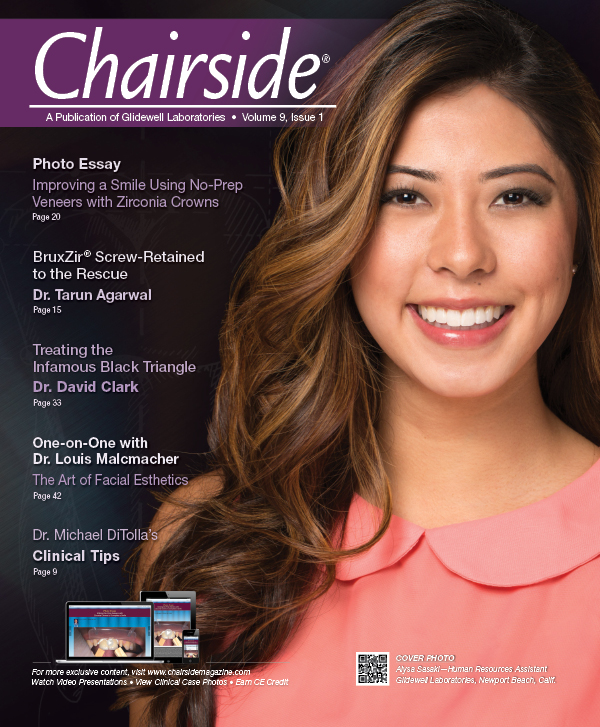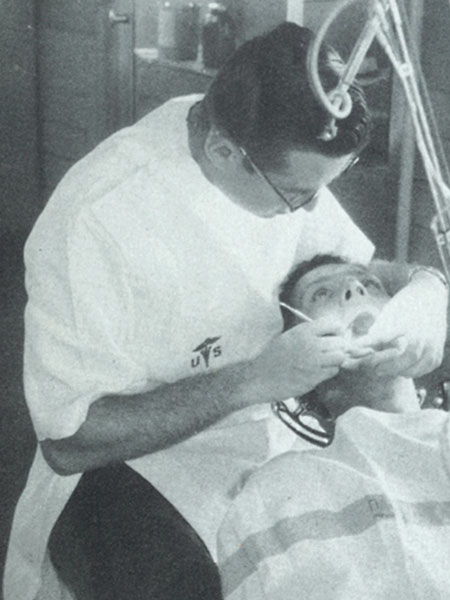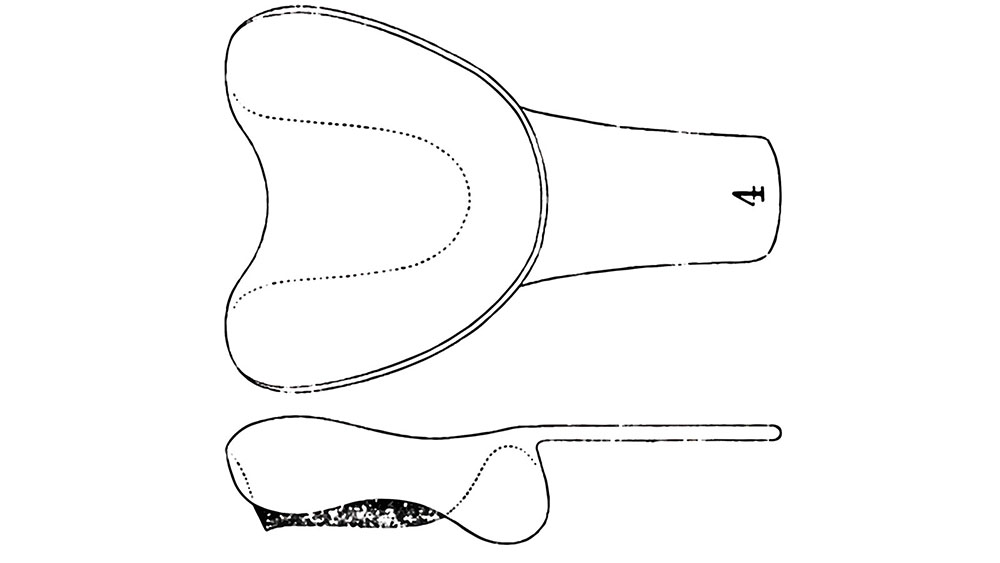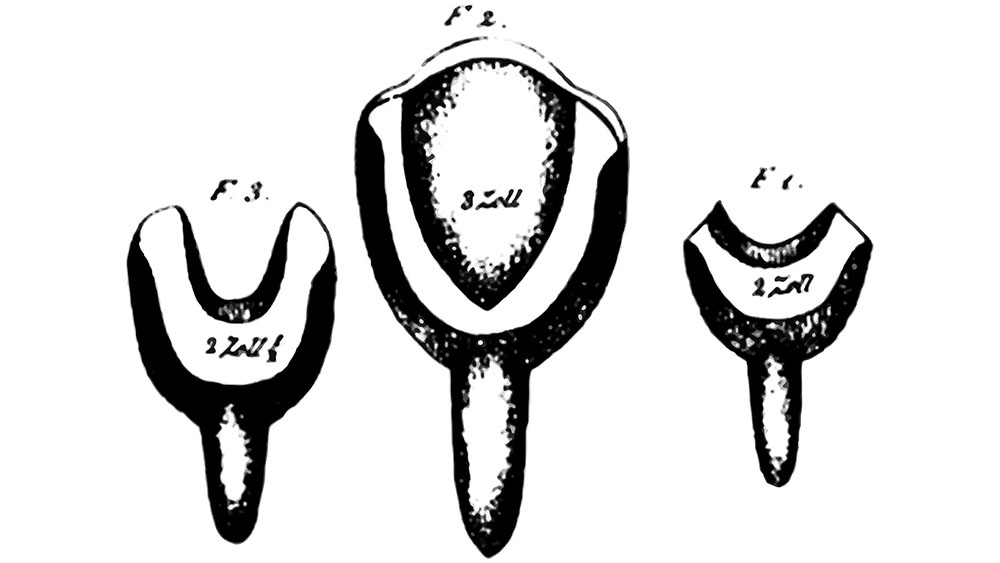How It Evolved: Dental Impressions

There is no record in ancient history of impression-taking in dentistry. Matthaus Purmann (1648–1711), a German surgeon, appears to have discussed making sketches and wax models from which prosthetic appliances were copied. The concept of taking impressions to make models, from which prosthetic appliances could be constructed, goes back to the early 18th century. Another German, Philipp Pfaff (1713–1766), dentist to Frederick the Great of Prussia, was the first to describe a technique of taking impressions with sealing wax, which had been softened in hot water, and pouring plaster of Paris into the impression to form a rigid cast.1,2
In November of 1787, John Greenwood ran an advertisement in the *New York Daily Advertiser*. This ad stated that "persons at any distance may be supplied with artificial teeth by sending an impression, taken in wax, of the places where wanted …" This appears to be an account of the earliest use of models in dental prostheses in this country. John Greenwood’s son, Isaac John Greenwood, in a letter to Dr. Jonathan Taft in 1861, states that neither his grandfather, Isaac Greenwood, who practiced in Boston prior to the Revolutionary War, nor his father, John Greenwood, who practiced in New York until 1820, used plaster of Paris to make models, but both used beeswax to make moulds. Isaac John Greenwood further states that he and his brother, Clarke, did not use plaster of Paris until 1820.3,4
In 1819, Levi S. Parmly, in his *A Practical Guide to the Management of the Teeth*, which was written primarily for popular consumption and published in Philadelphia, states that his method of making artificial teeth is "entirely new in this country, and is considered one of the greatest improvements in the dental art." He goes on to say, "Where the teeth are mostly gone, in both or in either of the jaws, the method is to form an artificial set, by first taking a mould of the risings and depressions of every point along the surface of the jaw, and then making a corresponding artificial socket for the whole."5
In 1820, the French dentist C.F. Delabarre introduced what is believed to be the first impression tray. According to him, "softened wax is to be placed in a small track, or semi-elliptical cast of white metal or silver, on the front side of which a haft or handle is mounted. The walls of this instrument provide resistance and keep the pressure of the cheeks away from the wax. After the cast has been pressed on firmly, it is carefully pulled off in the direction of the teeth and immersed in cold water. Then the excess is removed with a spring blade, and it is replaced briefly once more."6,7
In the second edition of Samuel Sheldon Fitch’s *A System of Dental Surgery*, published in Philadelphia in 1835, there is a discussion "of the manner of taking the shape and figure of the mouth." This book is the first complete and systematic American treatise on the practice of dentistry. Fitch says to take a piece of wax, usually beeswax, and to soften it in warm water or in a flame, after which it is pressed on the teeth and gums. He says that this will give "an exact impression." After the wax hardens, it is removed from the mouth and "a paste of the sulfate of lime, gypsum and plaster of Paris is poured into the mold. After setting, the wax is melted off." When a denture with a gold plate is to be constructed, Fitch advocates making a brass model from the plaster one.8
In 1839 in Baltimore, Chapin A. Harris published the first edition of his book *The Dental Art, Practical Treatise on Dental Surgery*. This was the most popular and widely distributed dental book of its time. It is referred to as the first American text on dentistry. Harris devotes a section to "the manner of obtaining a model." This information appears to be based on the above-mentioned work by Fitch, except that Harris goes into greater detail. Both recommend taking an impression with wax that is softened in warm water or over a flame (spirit lamp). Harris also advocates the use of well-calcined plaster of Paris gypsum for pouring models; this plaster should be passed through a fine sieve. The paste is then mixed with water and a thin mix first poured into the mold; to be followed by a thicker one, which should be at least one-half inch above the wax.
Harris goes further than Fitch by discussing the use of an impression tray. He says an impression of the posterior portion of the mouth cannot be taken without distorting the wax unless a frame is used to hold the wax. He states that every dentist should have a variety of frames in different sizes. These trays should have half-inch rims on both sides. An impression is taken by having the patient bite down on the wax, which gives an impression of both arches. Models are made by pouring plaster into one side at a time.
Because plaster models are not hard enough to form gold plates on, both Harris and Fitch recommend making metal models. Harris described in detail how this is accomplished. He made an impression of a plaster model in sand; a technique used in iron and brass foundries. This mold can be filled with a mixture of zinc and tin. He then explained in detail how a metallic impression is made on this model and a gold plate stamped out between the two.9
In 1844, Paul B. Goddard of Pennsylvania described a similar method of taking impressions and pouring models. He preferred a clean yellow beeswax, which has been immersed in warm water (100º F), for taking impressions. He placed the wax on one or both sides of what he called a box and had the patient bite down until the impression was taken. The patient was told to open slowly, so as not to cause distortion. Upon removal, a piece of waxed muslin was placed around the impression in order to deepen it. It was then placed on a table and calcined plaster poured in. A hammer was then used to hit the table several times to remove air bubbles. After the plaster set, the wax was removed from the model. Goddard took an impression of his plaster model in fine, damp sand containing a little molasses. From this, a model was made of brass, zinc or fusible metal. A reverse model was then made in soft lead, and both of these models used to form gold plate.10
As noted above, wax was the only impression material used in dentistry until the middle of the 19th century. The process of taking these impressions consisted of taking the warmed wax and forming it to the teeth and tissues. The wax then cooled and was carefully removed. At first, the wax was held with finger pressure, but because of the difficulty in holding the wax in place without its distortion, wax-holders were introduced. Plaster of Paris impressions were introduced around 1844–5. It is impossible to say who first used them, but credit is given equally to Amos Westcott, W.H. Dwinelle and E.J. Dunning.11,12 Plaster impressions have always been coated with a separating media, such as a varnish or shellac, before a cast could be poured.
Gutta percha was first used to take impressions in 1848. It was soaked in boiling water, kneaded and placed directly into a tray, which was then inserted in the mouth until it hardened, at which time it was removed. By 1876, this material was seldom used. In 1830, F. Maury of France illustrated a set of impression trays, and in 1843, reported the use of modeling wax, composed of 10 parts of wax and one part of turpentine, for taking impressions. He felt that this was too soft, and therefore preferred white or yellow wax. He also recommended a modeling wax composed of 12 parts white wax, one part white lead and one-half part oil. In 1857, Charles Stent of London tested a combination of different waxes and invented a thermoplastic modeling compound similar to those in use today.13 Compounds were intended to replace plain wax and plaster. But it was generally felt in the late 1870s that plaster would be the most important impression material for many years to come.14,15
In 1819, Levi S. Parmly, in his A Practical Guide to the Management of the Teeth, which was written primarily for popular consumption and published in Philadelphia, states that his method of making artificial teeth is "entirely new in this country, and is considered one of the greatest improvements in the dental art."
In 1871, James W. White, in his *Taking Impressions of The Mouth*, offers for sale a set of 15 upper and lower impression trays, designed by Mr. E.T. Starr, which are similar in design to those in use today. They were advertised as being made of a light metal, which could be adapted by finger pressure or pliers to obtain a better fit. Also advertised was Dr. B.W. Franklin’s impression tray in three sizes for taking lower plaster impressions. Another tray that was described was Dr. Thomas Wardle’s movable palate-plate tray.16 In addition to the trays designed by Starr, the 1876 S.S. White catalog also advertised porcelain impression trays. They were available in the same sizes and patterns as the metal ones and, like the metal ones, sold for 50 cents apiece.17
By 1887, as noted by A.G. Bennett in *The American System Of Dentistry*, "a perfect impression and a correct articulation constitute the basis of prosthetic dentistry." According to Bennett, the impression materials in use at that time were wax, gutta percha, modeling compound and plaster of Paris. He says each has its use; for example, he recommended a combination wax and plaster impression when constructing a partial upper denture. He states that compound is better than gutta percha because it does not stick or contract, and wax does not take as sharp an impression as compound or plaster. Bennett further states that modeling compound, which is available in different consistencies, is the newest of the materials, being composed of gum dammar, stearin, French chalk and carmine. Bennett admits that plaster is difficult to use and says that many practitioners who try plaster and find it difficult to work with switch to easier handling materials — wax or compound, which may not be as reliable.18
In the 19th century, there was much interest in taking impressions to construct full and partial dentures. This is noted by the fact that in the *Index of the Periodical Dental Literature*, over 200 articles are found on impression-taking and impression materials in American dental journals. There was also much written in textbooks on the subject; an example being the extensive treatment given at the turn of the century by H.H. Burchard, writing in the *American Textbook of Prosthetic Dentistry* and by James H. Prothero in his *Prosthetic Dentistry*.
In the early 20th century, there continued to be two basic types of impression materials: first, those which are made pliable by heat and harden upon cooling (wax, modeling compound and gutta percha); second, plaster, a material which is made plastic by being mixed with water and hardens by crystallization. Impression trays were fabricated of various materials and available in various sizes. They were made of block or alloyed tin, cased and pressed aluminum, German silver and porcelain. Porcelain was the cleanest material, but it couldn’t be modified, and it broke easily. Tin was popular because it could be bent and cut easily. Besides the above-mentioned stock trays, some dentists advocated using custom trays. Modeling compound became popular in America when Peter and Jacob Greene of Chillicothe, Mississippi, gave compound technique courses around 1910. They appear to be the first to teach the closed-mouth compound impression technique used in the construction of full dentures. Peter Greene also taught the use of plaster and compound combinations, called a "plaster wash." This technique was improved by Rupert Hall and became known as the "Hall Method." (Years later, impression paste washes containing zinc oxide and eugenol were preferred.)19,20
Modeling compound became popular in America when Peter and Jacob Greene of Chillicothe, Mississippi, gave compound technique courses around 1910. They appear to be the first to teach the closed-mouth compound impression technique used in the construction of full dentures.
The taking of impressions to construct partial dentures has always been more difficult than those for full dentures. Most failures were due to the fact that wax and compound would usually distort, and plaster impressions usually had to be removed in fragments and put together with sticky wax. This would result in an inaccurate reproduction of the tissues and undercuts around the teeth. Only material that was sufficiently elastic so that it could be removed from the mouth without distortion could solve this problem. As a result, flexible impression materials, which remain elastic after setting, were developed. The concept evolved from the use of jelly molds for taking impressions of still-life objects, such as statuettes. In 1925, Alphons Poller, an Austrian, invented and patented a material called "Nogacoll." In 1931, after the inventor’s death, the formula was acquired by a company that sold it under the name of "Denticole." Within a few years, nearly a dozen competing brands were on the market. All of these compounds were reversible hydrocolloids, with their fundamental ingredient being agar-agar, which is a vegetable colloid derived from seaweed. This jelly-like substance softened when heated and set when cooled. The technique of using this reversible colloid, which could be reused, was complicated because of the need for special heaters, syringes and water-cooled trays. When the types of algae used for the manufacture of agar-agar from the Japanese coast were no longer available in America during the Second World War, native brown algae was used. Chemical processing of this material yielded a new elastic impression material with an alginate base, which is easier to use. The dry alginate powder gels, when mixed with water, form an irreversible hydrocolloid alginate. Reversible hydrocolloids, containing agar-agar, are no longer used, whereas alginates are still advocated.21,22,23,24,25
Elastic impression materials were developed from synthetic rubber by S.L. Pearson at the University of Liverpool in 1955.26,27 The introduction of rubber-based, polysulfide impression materials was followed by silicone-based materials, both of which are still in use. Following these, elastic polyether impression materials were introduced, followed in recent times by polyvinylsiloxane impression materials. Besides impression materials, a variety of new impression trays and techniques for taking impressions have evolved. In the future, new impression materials and impression-taking techniques will be developed that will make a dentist’s work easier.
Dr. Richard A. Glenner is past historian of the American Academy of History of Dentistry and is now retired.
Reprinted by permission of the Journal of the History of Dentistry, ©1997 American Academy of the History of Dentistry.
References
- ^ Guerini V. A history of dentistry. Philadelphia & New York: Lea & Febiger; 1909. p. 241-2, 305-6.
- ^Bremner MDK. The story of dentistry from the dawn of civilization to the present. New York & London: Dental Items of Interest Pub Co., Inc.; 1958. p. 91.
- ^Weinberger B. An introduction to the history of dentistry, vol. 2. St. Louis: Mosby; 1942. p. 225, 253.
- ^Greenwood IJ. The early history of the profession in the United States. Dent Reg. 1861;15:29-37.
- ^Parmly LS. A practical guide to the management of the teeth. Philadelphia: Collins & Croft; 1819. p. 138.
- ^Delabarre CF. A treatise on the mechanical part of the art of the dentist. Paris: [publisher unknown]; 1820.
- ^Hoffmann-Axthelm W. History of dentistry. Chicago: Quintessence Pub. Co., Inc.; 1981. p. 284.
- ^Fitch SS. A system of dental surgery. 2nd ed. Philadelphia: Carey, Lea & Blanchard; 1835. p. 427-8.
- ^Harris CA. The dental art, practical treatise on dental surgery. Baltimore: [publisher unknown]; 1839. Classics of Dentistry Library edition. p. 348-55.
- ^Goddard PB. The anatomy, physiology and pathology of the human teeth. Philadelphia: Carey and Hart; 1844. p. 170-1.
- ^American Academy of Dental Science. A history of dental and oral science in America. Philadelphia: Samuel S. White; 1876. p. 46-7.
- ^Harris CA. A dictionary of dental science. Philadelphia: Lindsay & Blakiston; 1849. p. 385-6.
- ^Maury F. Treatise on the dental art. Philadelphia: Lea & Blanchard; 1843. p. 189-90.
- ^American Academy of Dental Science. A history of oral and dental science in America. Philadelphia: Samuel S. White; 1876. p. 47.
- ^Hoffmann-Axthelm W. History of dentistry. Chicago: Quintessence Pub. Co., Inc.; 1981. p. 268.
- ^White JW. Taking impressions of the mouth. Philadelphia: Samuel S. White; 1871. p. 55-75.
- ^S.S. White dental catalog. Philadelphia: Samuel S. White; [date unknown]. p. 207-317.
- ^Litch WF, editor. The American system of dentistry, vol. 2. Philadelphia: Lea Brothers & Co.; 1887. p. 453-73.
- ^Wilson GHA. Manual of dental prosthetics. Philadelphia & New York: Lea & Febiger; 1917. p. 56-63.
- ^Bremner MDK. The story of dentistry from the dawn of civilization to the present. New York & London: Dental Items of Interest Pub. Co., Inc.; 1958. p. 222.
- ^Lufkin AW. A history of dentistry. Philadelphia: Lea & Febiger; 1938. p. 214-6.
- ^Hoffmann-Axthelm W. History of dentistry. Chicago: Quintessence Pub. Co., Inc.; 1981. p. 284.
- ^Bremner MDK. The story of dentistry from the dawn of civilization to the present. New York & London: Dental Items of Interest Pub. Co., Inc.; 1958. p. 225-6.
- ^Craddock FW. Prosthetic dentistry. St. Louis; Mosby: 1951. p. 62-6.
- ^Heartwell CM. Syllabus of complete dentures. Philadelphia: Lea & Febiger; 1968. p. 136-8.
- ^Hoffman-Axthelm W. History of dentistry. Chicago: Quintessence Pub. Co., Inc.; 1981. p. 284.
- ^Pearson SL. A new elastic impression material: a preliminary report. Br Dent J. 1955;99:72-6.






